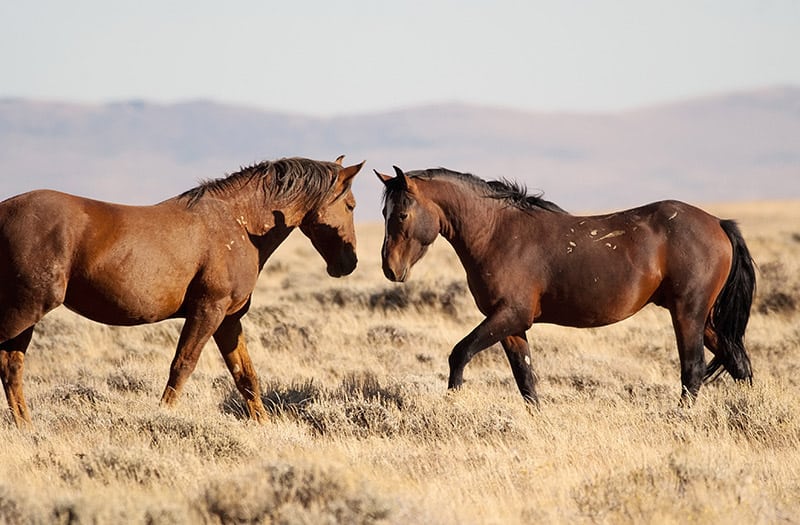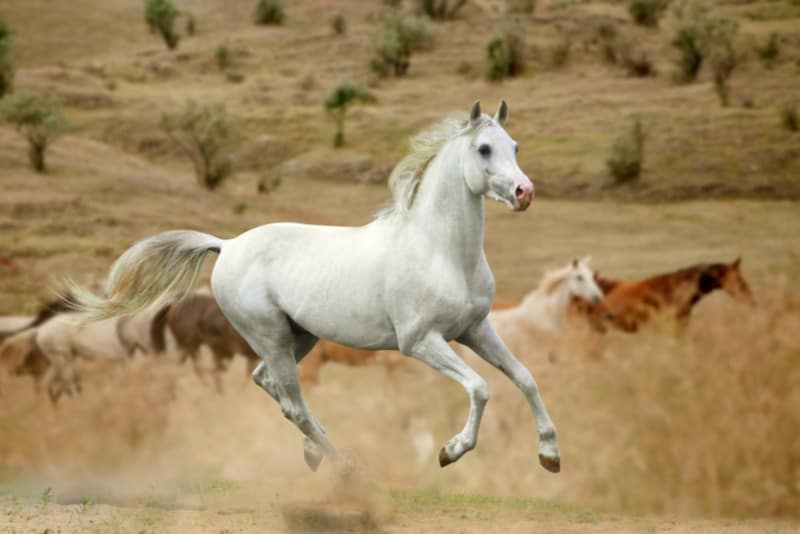Mustangs have run as wild horses in North America for several hundred years, and still do today!
The American Mustang is descended from the Spanish horses that were brought with the Conquistadors in the 16th Century. At one time over one million Mustangs roamed over most of North and Central America. A hardy animal, the Mustang has survived in the wild for several hundred years.
The Mustang is the embodiment of the spirit and freedom of the early development of the United States. It is often thought of as a symbol of the American West and is considered one of the native American horses. Free roaming Mustangs are primarily wild horses, but they are quite often captured and gentled. The American Mustang is favored for its rugged toughness and endurance. They have an independent spirit and will do as they please, but they are highly intelligent. With good treatment and proper training they are quick to learn.
Scientific Classification
| Kingdom: | Animalia |
| Phylum: | Chordata |
| Class: | Mammalia |
| Order: | Perissodactyla |
| Family: | Equidae |
| Genus: | Equus |
| Species: | caballus |
Horse Breeds
The American Mustang is a light horse breed. Light horse breeds generally weigh under 1,500 pounds. They are typically used as riding horses for leisure and trail riding. Being agile and swift, many are also used on the racetrack, in the show ring, and for work on the ranch.
Light horses are grouped in a couple of different ways, one being the continent or country where they originated from. They are also grouped according to training, classified as either a stock type, hunter type, saddle type, or ‘other’. A body type is generally attributed to each class, with the ‘other’ classification being a bit of an odd ball. It includes those that are color breeds or those that may fit a body type of one of the training classes, but not be used for that type of training. The ‘other’ types can also include those that may fit into more than one of the type groups.
The horse class the American Mustang fits into is the ‘other’ class.

Horse Backgrounds
Some of the Spanish horses brought by the Conquistadors in the 16th Century escaped and began to form large herds that spread from Central America up into the plains of the present-day United States. It is estimated that at the beginning of the 20th Century over one million wild horses roamed the mountains and plains of the United States. By 1970, due to hunting for meat, the number of native American horses fell dramatically so that fewer than 17,000 mustangs remained.
A wild horse lover named Velma B. Johnston, who was later nicknamed ‘Wild Horse Annie,’ became aware of the ruthless slaughter of wild horses and began a grassroots campaign to protect them. Her efforts led to a bill being passed in 1959 (known as the ‘Wild Horse Annie Act’) which prohibited the use of motorized vehicles to round-up horses on public lands. It was not until 1971 that the American Mustang was declared an endangered species and was protected by law under the Wild Free-Roaming Horse and Burro Act. The wild herds have recovered under government protection and the U.S. Bureau of Land Management (BLM) estimates that there are currently around 50,000 Mustangs living in the United States. The BLM conducts its own round-ups in some areas to help prevent overpopulation and these horses and burros are put up for adoption.
American Mustang enthusiasts have created several breed registries and organizations to preserve and manage Mustang stocks. Some of these are the North American Mustang Association and Registry, the Spanish Barb Breeders Association, and the International Society for the Protection of the Mustang and Burros.
Description
Mustangs come in all sizes, shapes, and colors, with the average height being around 14.2 hands. The most common colors are bay and sorrel, but they come in buckskin, appaloosa, zebra striped dun, grulla (slate gray), roan, palomino, and paint.
Horse Care and Feeding
The Mustang’s ancestors ran wild in the Americas, and they developed into a hardy breed with simple nutritional requirements. Mustangs had to survive on small amounts of grass and brush so they tend to be easy keepers and maintain weight on fairly low amounts of feed.
The Mustang is a fairly low maintenance breed that does well in most settings. The breed does equally well in pasture or in a barn or box stall.

Horse Training and Activities
Mustangs usually have an even temperament. They are very intelligent and willing to learn. These horses can be used for a variety of disciplines, from pleasure riding to endurance.
Common Health Problems
Mustangs are known to be very sound and have good, strong hooves. Hardy and robust, the well cared for Mustang should not be prone to any special health risks.
Availability
Mustangs are readily available and very inexpensive through the Bureau of Land Management Wild Horse and Burro facilities. It is best to adopt a Mustang as young as possible so that they become used to being handled and trained for ground manners. Even older Mustangs can be trained to be good riding horses, but it requires patience and a knowledgeable person.
Featured Image Credit: mariait, Shutterstock
